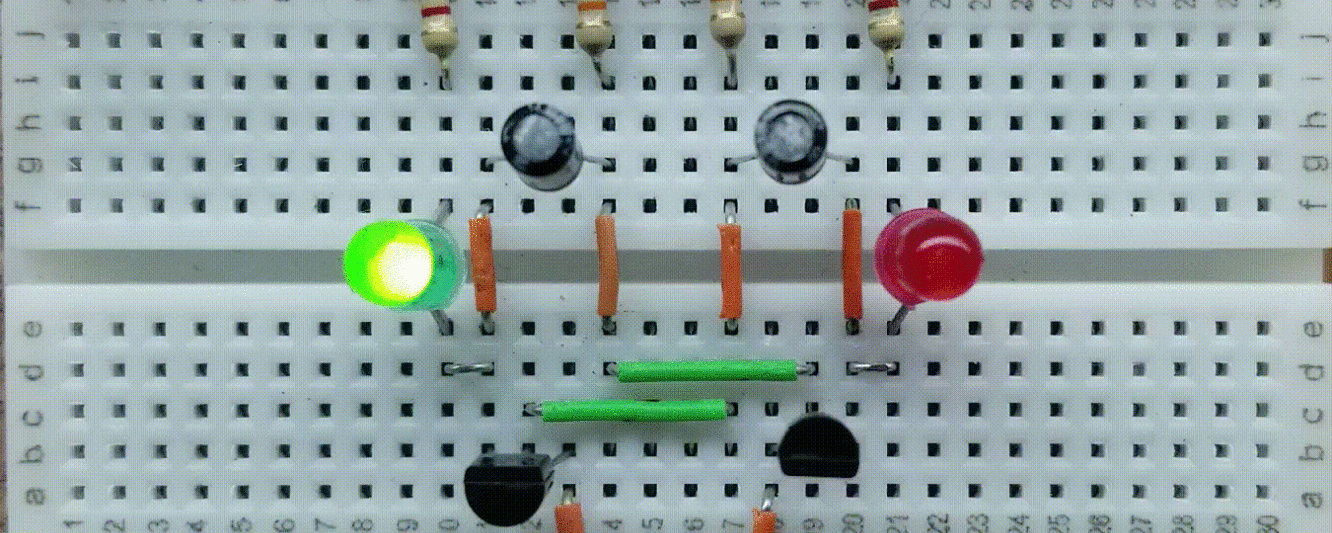
Hands On Ohm’s Law Project
Project Overview
As with any lab project on BreadBoardCircuits.com, building the circuits are recommended, but not necessary. If you wish to just read along, you will still get a great deal of useful information out of the article.
With this beginner’s project, you will learn Ohm’s Law basics and beyond – in theory and on the breadboard. You’ll calculate the current through a single resistor and confirm that calculation with a amp-meter measurement. You will then create a parallel resistor arrangement, calculate the equivalent resistance, and the current through each resistor. You’ll then move on to a series arrangement and learn about the voltage divider and how to calculate the voltage across each resistor. After confirming your calculations on the breadboard, you will have an understanding about how current flows and is distributed, as well as how voltage appears and is divided. Finally, you will learn how to calculate power and how changes in voltage and current affect power output. To learn exactly what voltage and current are, please see this article first.
Before building a breadboard, please review our safety procedures and recommendations page.
Supplies Needed
- Minimum breadboarding equipment (see here)
- (3) 1k Ohm 1/4 watt resistors
- (1) 470 Ohm 1/4 watt resistor
Ohm’s Law
According to “Ohm’s law”, the current through a load, such as a resistor is proportional to the voltage across that load. This yields the Ohm’s law triangle as shown in the image below.
Where V = voltage, I = current, and R = resistance.
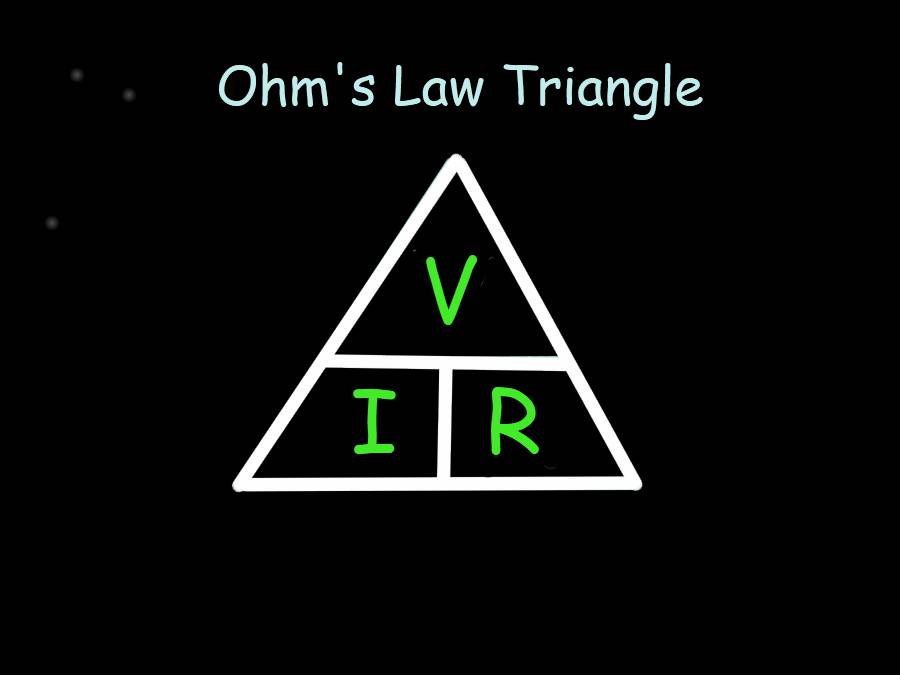
The Ohm’s law triangle readily shows the mathematical relationship between the the three variables. Thus, if you want to find voltage, you multiply the I and the R at the bottom. If you want to find current, you divide V by R. To find resistance, you divide V by I. For DC circuits, finding V, I, or R is as simple as plugging in the values. For AC RMS voltage, when using resistive loads, Ohm’s law can be equally applied as described above.
Experiment #1 – Current through a Single Resistor
We’ll demonstrate Ohm’s law in simple form by applying a voltage across a single resistor. A voltage of 10 volts DC will be connected across a 1k ohm resistor. The calculated current, based on the Ohm’s law triangle is (10 volts)/(1000 ohms) = 0.01 amps or 10 milliamps (mA). This is the value that we would expect to measure with an amp meter. Traditionally, an amp meter is connected in parallel with the circuit. We will use a Fluke multimeter to do this. Below is shown both the schematic for this experiment as well as the breadboard and associated measurements.
Note that if we reduce the voltage to 5 volts, the current proportionally decreases to 5 mA, which corresponds to the Ohm’s law equation per the triangle. The measurements are shown below.
Picture here

Experiment #2 – Resistors in Parallel
Parallel resistors increase the total current flow through the circuit. Thus, the equivalent value of 2 parallel resistors is always less than the value of either one.
Equivalent Resistance
The equivalent resistance of parallel resistors is calculated by 1/Rp = 1/R1 + 1/R2 + 1/R3 ….., where Rp is “R parallel” or the parallel equivalent resistance. If you only have 2 parallel resistors, you can use the shortcut equation Rp = (R1 x R2)/(R1 + R2).
Let’s connect (2) 1k resistors in parallel. Based on the first equation above, we have 1/Rp = 1/1000 + 1/1000. Thus Rp = 1000/2 or 500 ohms. Using the shortcut equation, we have (1000 x 1000)/(1000+1000) = 1000000/2000= 500 Ohms.
Below is a breadboard with 2 parallel 1k ohm resistors. Note that the equivalent resistance that the Fluke multimeter reads is approximately 500 ohms.
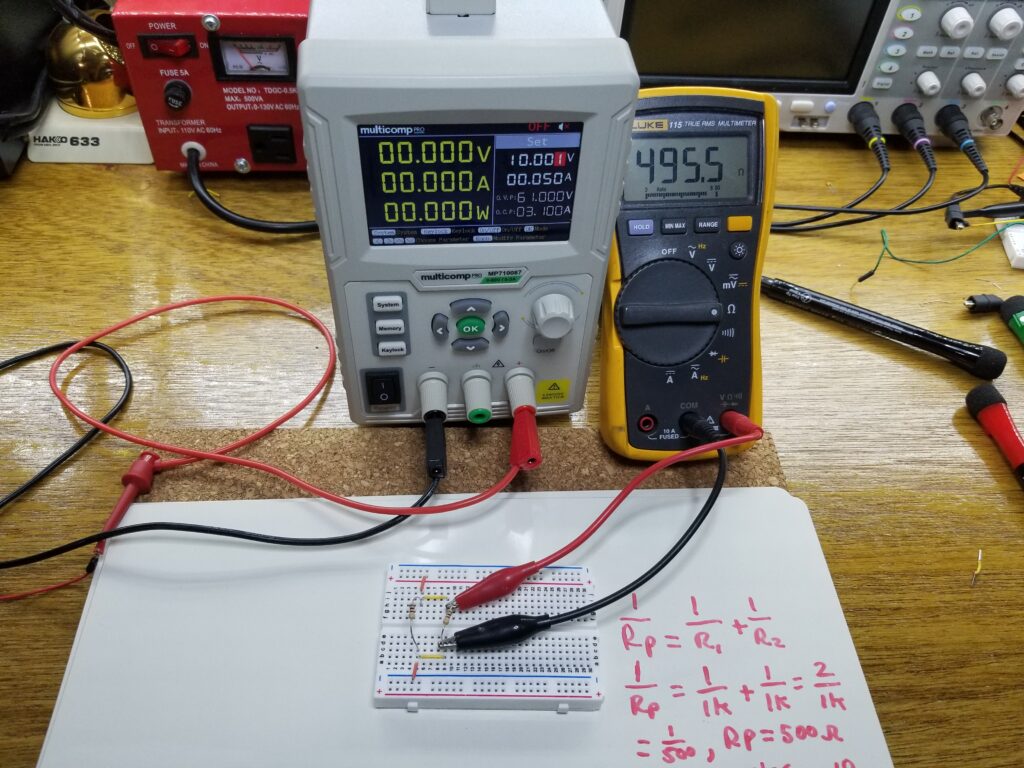
Current through Parallel Resistors
Two resistors in parallel, such as in the above experiment, doubles the circuit current. The proportionality of Ohm’s law requires it. Let’s re-use the last experiment. We have two 1k ohm resistors in parallel. That is 500 ohms. If we apply 10 volts DC across that circuit, we should have (10 volts) / (500 ohms) = 20 mA. This is confirmed by measurement (below). That 20mA is being divided equally among the two resistors. How do we know that? It is simple. Each resistor has 10 volts across it. We know the value of each resistor. Thus 10 volts across each 1k resistor is 10mA per Ohm’s law. The current through each resistor adds up to 20 mA. The current division can be calculate by the formula: IR1 = Itotal x (R2/(R1+R2)) and IR2 = Itotal x (R1/(R1+R2)). So calculating for IR1, we have 10mA x (1k/(1k + 1k)) = 10mA x (1k/2k) = 10mA x 1/2 = 5mA. Calculating for IR2, we have we have 10mA x (1k/(1k + 1k)) = 10mA x (1k/2k) = 10mA x 1/2 = 5mA.
This is verified by testing the current trough each resistor using the Fluke multimeter as shown below:
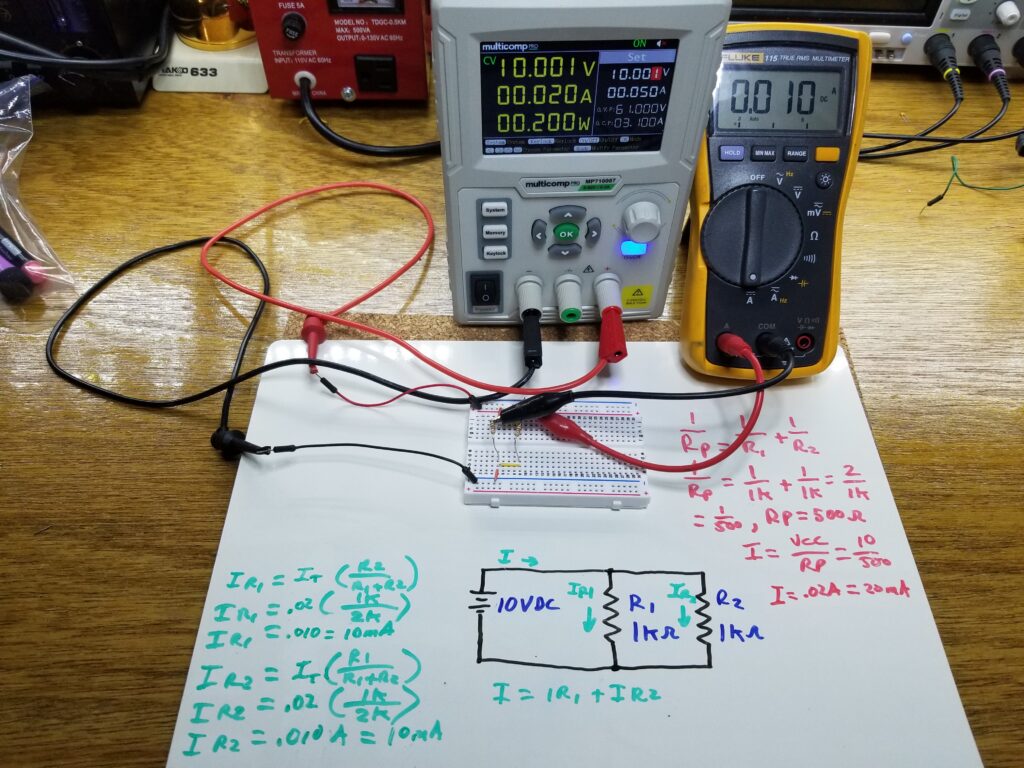
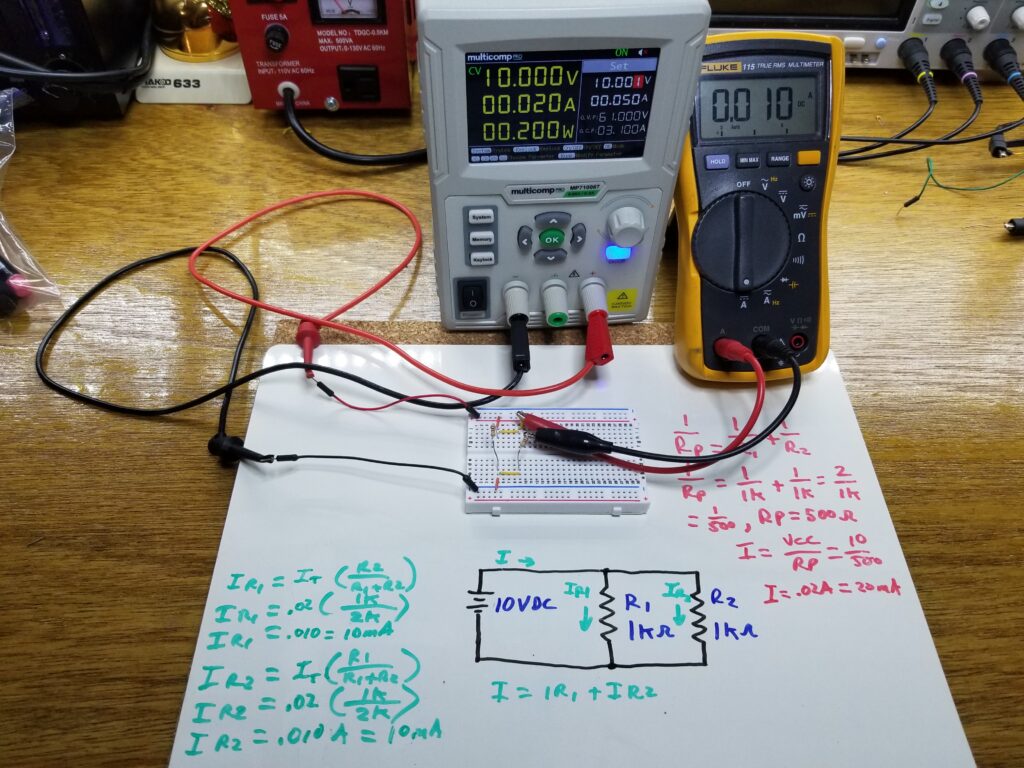
Experiment #3 – Resistors in Series and Equivalent Resistance
The resistance of series resistors is much easier to calculate. It is simply the sum of the resistances. Thus two 1k ohm resistors in series has a total resistance of 2k ohms. This is shown in the images below.
Current through Series Resistors
The current through series resistors is the same through each resistor and equals the total circuit current. Thus a circuit with two 1k ohm resistors in series has a total resistance of 2k ohms and a current of 5 mA, which is the same all through the circuit.
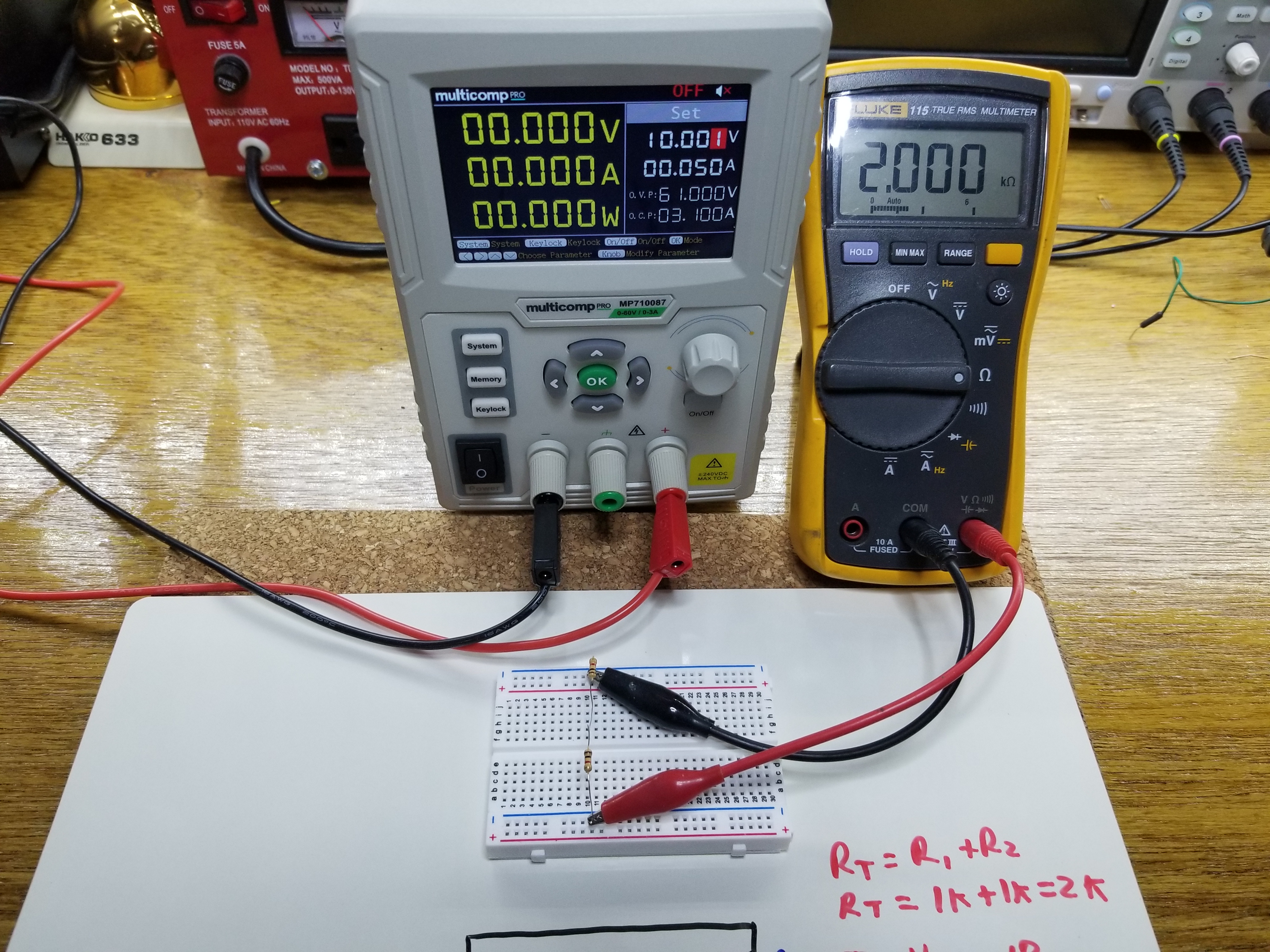
Schematic picture with breadboard
Experiment #4 – Voltages Across Series Resistors – The Voltage Divider
An important and often used configuration in electronics is the voltage divider. It is the basis for many types of circuits. It is based on series the resistance as described previously. In fact, to demonstrate it, we will use the same configuration as in the previous experiment. You have two 1k ohm resistors in series and a 10 volt source across the circuit. Just like current in parallel circuits, the inverse is true with voltage in series circuits. The voltage is divided between the series resistors. The sum of all the divided voltages adds back up to the source voltage. The formula for this is as follows: Vr1 = Vsource x (R1/(R1+R2) and Vr2 = Vsource x (R2/(R1+R2) . Let’s first try this with the two 1k resistors. The formula for the voltage across each resistor above yields 5 volts each. This is confirmed with the breadboard measurements.
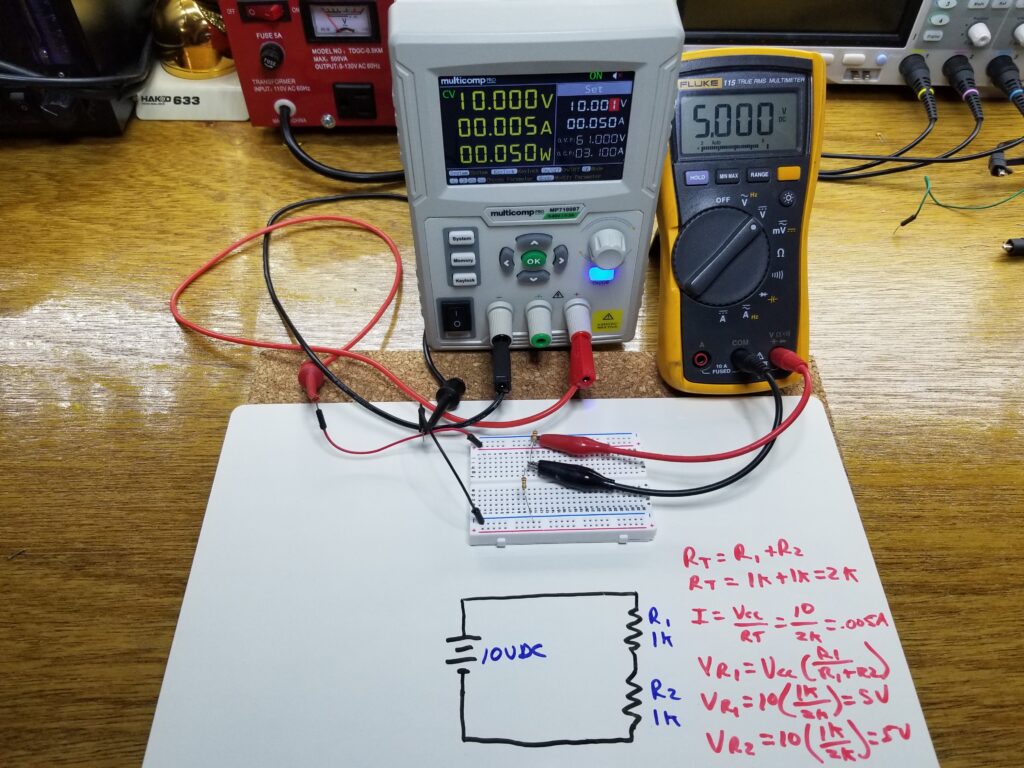
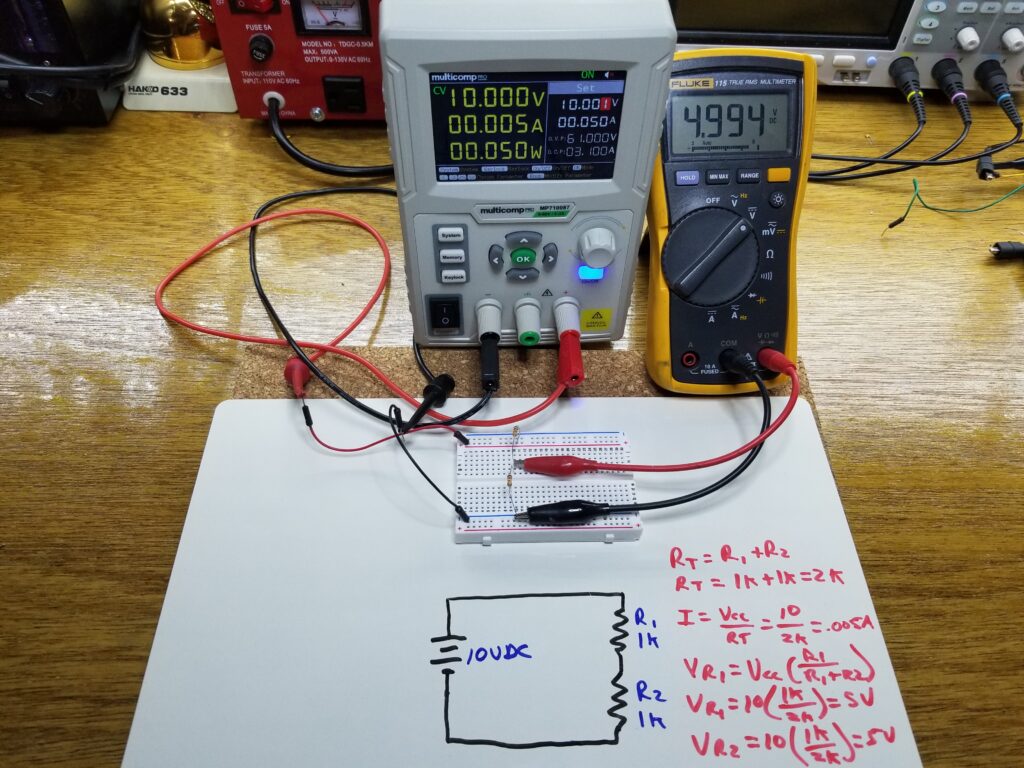
Now lets use 1k ohms for R1 and 470 ohms for R2. In this case the voltage across each resistor will not be the same. To calculate the voltage across R2 you have Vr2 = Vsource x (R2/(R1+R2) = 10v x (470/(1k +470) = 10v x (470/1470) = 3.2v. This is confirmed on the breadboard measurements below.

So you can see how useful voltage dividers can be. If you wanted to create a 3.2 volt source for any reason, out of a 10 volt source, you could do it in the above manner.
Experiment #5 – Power
Electrical power is defined as the rate (per time) that electrical energy is transferred by a circuit. Electrical power is measured in watts, which equates to one joule of energy per second. Current flowing through a resistor will generate heat. The heat that the resistor dissipates is measured in watts and can be calculated by the following equations using current, resistance, and voltage: P= VxI or P = I²xR or P=V²/R . To illustrate the heat generated by a resistor, we will take a 470 ohm, 1/4 watt resistor and connect enough voltage across it to generate 1/4 watt (the same as what the resistor is rated for). That voltage is 10.8 volts. Let’s calculate the power. P=V²/R, thus P=(10.8 x 10.8)/470 = 0.248 watts. Since the resistor is a 1/4 watt resistor, the resistor will be dissipating its maximum rated power and will be too hot to touch. In fact it will burn your finger if you try.
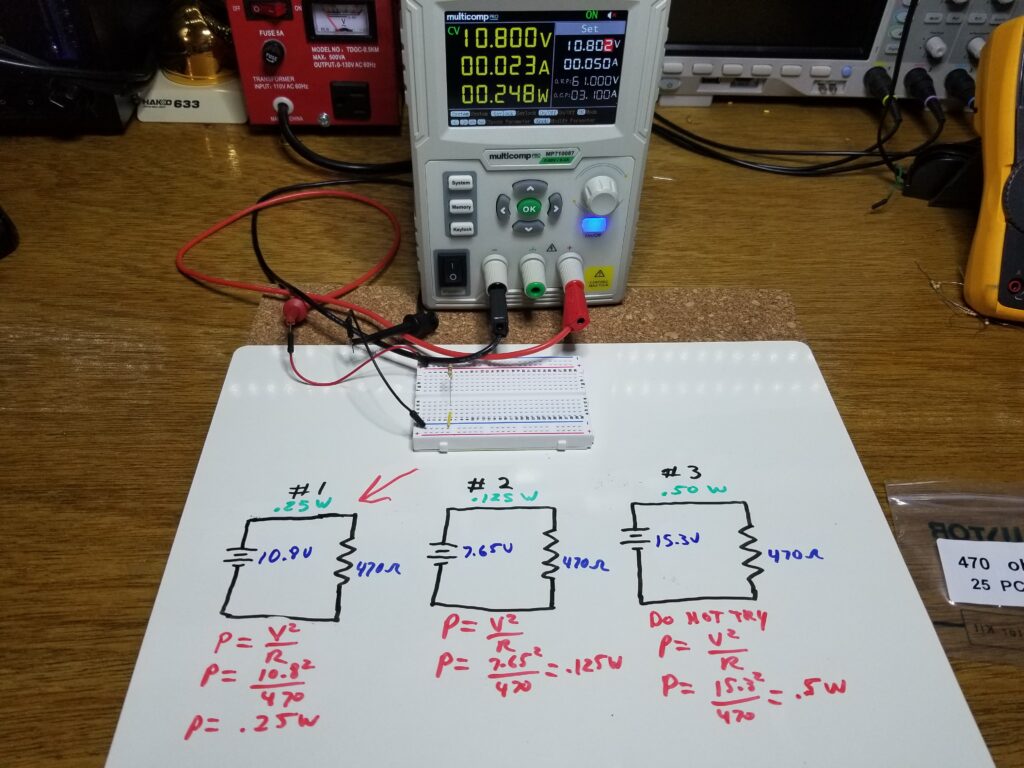
Power Increase by Voltage
What happens if you double the voltage across a resistor. Will the power (heat output) double? No. It increases by a factor of four. Let’s drop the voltage across the resistor from the previous experiment so that we have 1/8th of a watt being generated by it. That would be 7.65 volts. Let’s verify: P=V²/R, so (7.65×7.65)/470 = 0.125 watts (1/8th of a watt).

The following is not part of the experiment, and is just for illustration. If you were to double that voltage (which you don’t want to do), you would not have 1/4 watt of power, you would have four times that or 1/2 of a watt. That can be calculated by 7.65 x 2 = 15.3 volts. Since P=V²/R, you have (15.3×15.3)/470 = 0.498 watts. You don’t want to try this as the resistor will be hot enough to severely burn your finger. However, below is an image of the current flow, calculated power, and what would happen to the resistor.

If you were to subject the resistor to this kind of wattage for long, it would just burn up, as illustrated in the two pictures below.

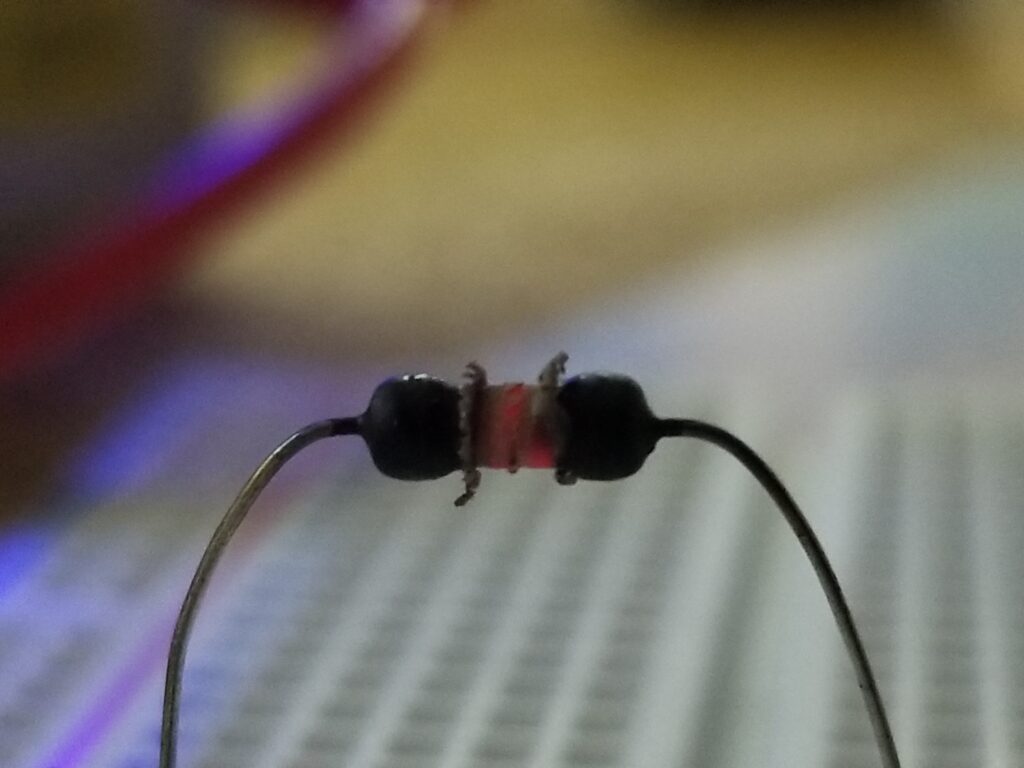
Conclusion
Current, voltage, Ohm’s law, Parallel and series resistances, current division, voltage dividers, and resistive power are all fundamental electrical concepts. They should be considered essential basic underpinnings for anyone interested in troubleshooting electronics or building circuits as a hobby. Understanding them will pay significant dividends going forward, where incomprehension of them will impede your electronics related endeavors.
For a better experience building breadboarded circuits, please see our page detailing the minimum recommended lab equipment for your electronics bench. Also, don’t forget to review the recommended safety procedures to follow when building and testing breadboarded circuits.
Finally, for other interesting breadboarded circuits please visit the home page here or our YouTube channel here.
SM
We are a participant in the Amazon Services LLC Associates Program, an affiliate advertising program designed to provide a means for us to earn fees by linking to Amazon.com and affiliated sites.
